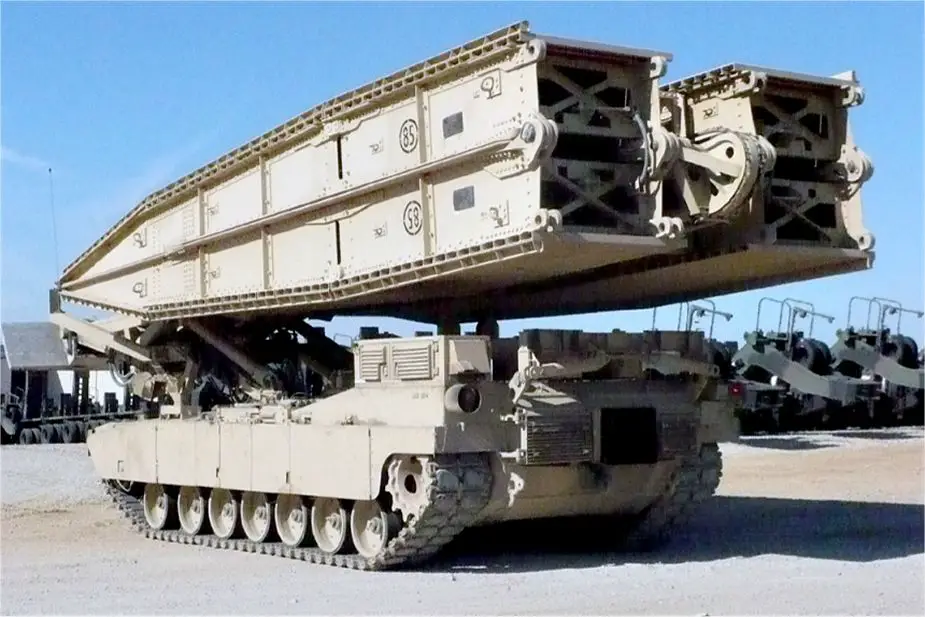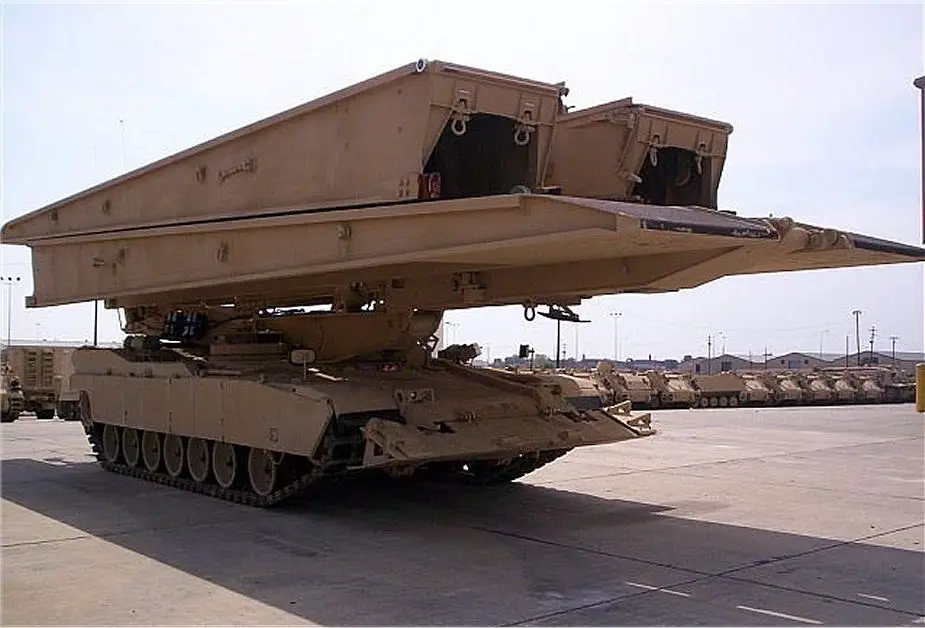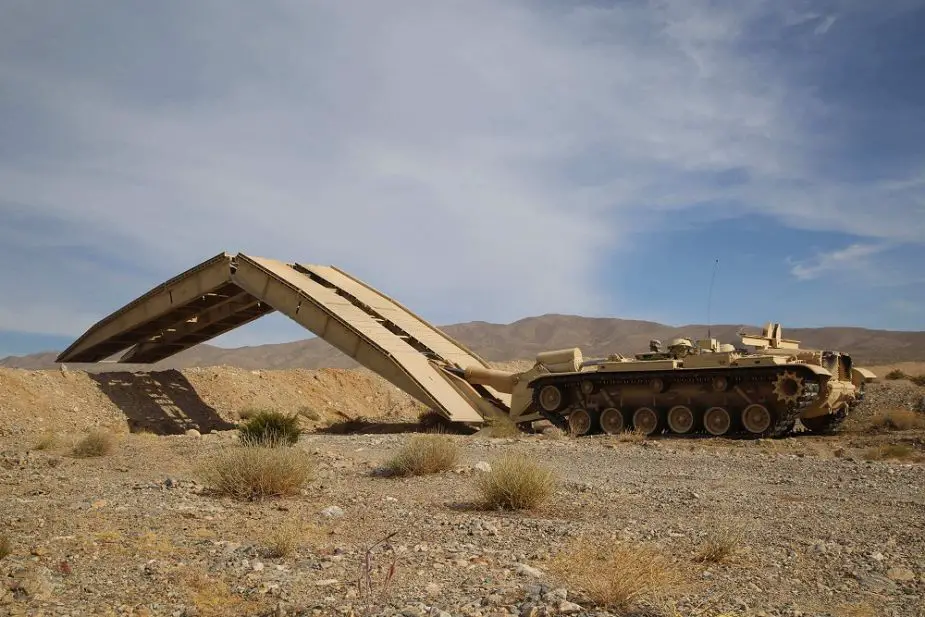Review of the U.S. Army Joint Assault Bridge (JAB) M1074, the next generation of assault bridge layer based on M1A1 Abrams Main Battle Tank (MBT) chassis and hull with heavy (M1A2) suspension integrated with a hydraulic bridge launcher system to launch the existing Military Load Class 85 Armored Vehicle Launched Bridge (AVLB). The JAB provides gap-crossing capability to cross wet or dry gaps, and freedom of maneuver on the battlefield to keep pace with Abrams Heavy Brigade Combat Team operations.

Leonardo DRS M1074 Joint Assault Bridge JAB. (Picture source Leonardo DRS)
The M1074 Joint Assault Bridge (JAB) is an armored military engineering armored vehicle based on the Abrams M1A1 Main Battle Tank (MBT). The 120mm cannon turret of the M1A1 Abrams is removed and the top of the chassis is equipped with a Scissor Bridge (MLC95). The Bridge Launcher Mechanism (BLM) was designed by Israel Military Industries in conjunction with Leonardo DRS. Bridging controls are a basic push-button system, similar to the M104 Wolverine, while the computer assembles the bridge and deploys it. The bridge extends its span vertically instead of horizontally as the M104 Wolverine. It can deploy an MLC95 bridge with a gap crossing of 11 meters in approximately 3 minutes.
The M1074 is designed by Leonardo DRS Technologies to provide deployable bridge capability for units engaged in military operations. Prototype development began in May 2012 when the U.S. Army Contracting Command awarded General Dynamics Land Systems and Leonardo DRS a $26 million contract to build two Joint Assault Bridge System (JABS) prototypes. The JAB is an Acquisition Category II program. The overall Acquisition Objective for JAB is 365 units. The Army will purchase 337 vehicles. The Marine Corps will purchase 28 vehicles.
The JAB was designed to support M1 Abrams-equipped units in Marine Air Ground Task Forces (MAGTF). The U.S. Army assumed the lead for the JAB program in 2010 after the Marine Corps canceled the program due to cost and performance concerns. The Marine Corps remains involved and is seeking to procure 28 JAB systems in conjunction with the Army.

Leonardo DRS M1074 Joint Assault Bridge JAB. (Picture source Leonardo DRS)
The design concept includes an M1A1 Abrams chassis with M1A2 heavy suspension and a contractor-designed, integrated hydraulic bridge launch mechanism for the Military Load Classification-95 Bridge.
The U.S. Services intend JAB to improve survivability and provide improved mobility ensuring freedom of maneuver, improved supportability, and enabling use of common battlefield communication suites.
The first prototypes of XM1074 JAB were ready in 2014. They were delivered to Anniston Army Depot (ANAD) where they underwent testing and evaluation through 2016 with the Leonardo prototype being accepted as the M1074 in August. According to the annual report 2019 of the U.S. Department of Defense, the U.S. Army conducted the Joint Assault Bridge (JAB) IOT& at Fort Bliss, Texas, April 2 – 29, 2019. Poor system reliability limited availability of JAB systems during the IOT&E. The result was insufficient data for DOT&E to determine operational effectiveness.
In Fiscal Year 2019, the Program Office implemented several JAB design changes to mitigate some of the vulnerabilities identified during the JAB LFT&E in 2018. The U.S. Army has started new live-fire testing in the beginning of 2020 to evaluate the effect of new changes on vehicle survivability.
The JAB will replace the Wolverine and M48/M60 chassis-based Armored Vehicle Launched Bridge systems in the Armored Brigade Combat Team (ABCT) Brigade Engineer Battalions and in Mobility Augmentation Companies supporting ABCT operations.

U.S. Army M104 Wolverine Heavy Assault Bridge (Picture Source Wikipedia)
The M104 Wolverine Heavy Assault Bridge is an armored military engineering vehicle created by General Dynamics Land Systems, designed to provide deployable bridge capability for units engaged in military operations.
The M104 Wolverine is based on a M1A2 SEP main battle tank chassis with a Leguan bridge-laying gear instead of a turret, it shares virtually all of the parent vehicle's speed, mobility, survivability, and automotive components. This commonality was a key design factor in the Wolverine's development. The Wolverine also features an advanced communications package designed to keep it in contact with local field commanders. However, the vehicle itself is unarmed.
The Wolverine is operated by two crewmen who sit within the hull. Both crewmen have access to the bridging controls, while the bridge is carried in two sections, stacked above the hull. Once a bridging site is chosen the vehicle securely anchors itself in place with a spade. The two sections of the bridge are joined together, and then the entire bridge is extended across the obstacle and dropped into place. The crewmen have the ability to make minor corrections during launch if needed. Once operations are complete, the Wolverine drives across the bridge and retrieves it from the other side simply by reversing the process. The bridge can be launched in under five minutes or retrieved in less than ten minutes, all without the crewmen ever leaving the safety of their vehicle.
Once launched, the 26-meter Leguan bridge can support a 70-ton vehicle moving at 16 km/h, or 10 miles per hour. The Wolverine thus allows the heaviest of vehicles to cross craters, ditches, and damaged bridges at combat speed. This mobility is a decisive advantage for armored units.

U.S. Army M60 AVLB Armored Vehicle-Launched Bridge (Picture source U.S. DoD)
The M60 AVLB is an armored vehicle based on the M60 Patton main battle tank's hull and used for the launching and retrieval of a 60-foot (18 m) scissors-type bridge. The AVLB consists of three major sections: the launcher, the vehicle hull, and the bridge. The M60 AVLB or Armored Vehicle Launched Bridge was introduced in 1963. This combat engineer vehicle was developed by the US Army Engineer Research & Development Laboratories under contract with General Dynamics to replace the previous M48 AVLB. It was designed to launch bridge for tanks and other wheeled combat vehicles across trenches and water obstacles in combat conditions. A total of 400 armored bridge launchers and bridges were built. 125 M60 AVLBs of all variants were constructed.














